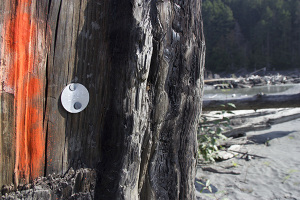By: Northwest Indian Fisheries Commission
The Lower Elwha Klallam Tribe is tagging large woody debris to follow it as it moves through the newly restored Elwha River system.
“We’re tracking over 2,000 logs and tree stumps with silver tree tags, from the upstream end of Lake Mills to the river mouth,” said Vivian Leung, a doctoral student of geomorphology at University of Washington.
She’s been working with the tribe since 2012 to study how large wood debris (LWD) has affected the river during and after the removal of the river’s two-fish blocking dams.
“Not only did the dams completely block the supply of sediment downstream, but they also altered the transportation of large wood,” said Mike McHenry, the tribe’s habitat manager. “Both elements are critical for habitat forming processes not only in the river but in the nearshore. The fate of wood is relevant to the recovery of the river and its aquatic resources, especially salmon.”

Silver tags are attached to log and stumps throughout the Elwha River so scientists can track their movements as the river changes during restoration.
As the dams came down, the lake Aldwell and Mills reservoirs were drained, leaving behind thousands of logs and tree stumps that had been buried under sediment and water for the past century. The natural action of the river is transporting the logs and stumps throughout the new riverbed, changing the dynamics of the river and creating better salmon habitat.
Leung is interested in how logjams form and affect channel patterns, how wood is transported through rivers and how the pools they create provide places for salmon to rest, feed and spawn.
“Surprisingly, there’s still a lot of research to be done to understand how large wood debris interacts with river systems,” she said. “So far we have found that logjams and salmon habitat are forming significantly faster in Aldwell than we expected.”
The large logs and rootwads also are aiding revegetation efforts of the lakebeds. The tribe hired a heavy-lift helicopter recently to relocate 500 unmarked logs around Mills. The logs were moved from the former reservoir pool elevation to terraces along the river’s floodplain.
These logs are expected to help stabilize steep slopes and provide sheltered areas for young plants to survive during planned revegetation efforts in the coming years, McHenry said. During 2014-2015, 100,000 woody plants will be planted into the former Mills reservoir surface.
